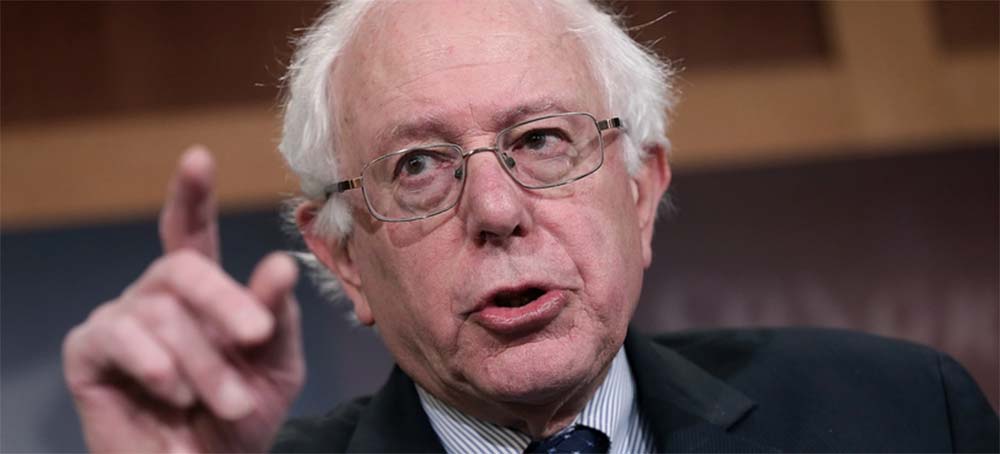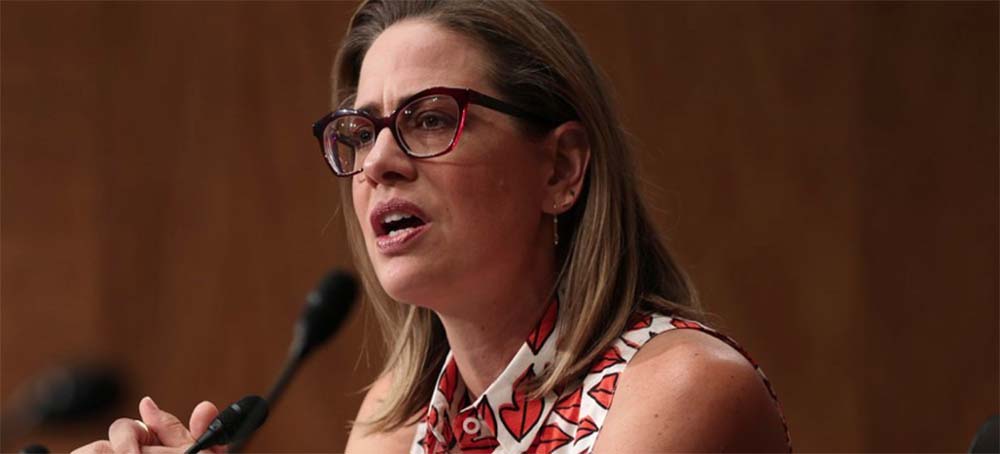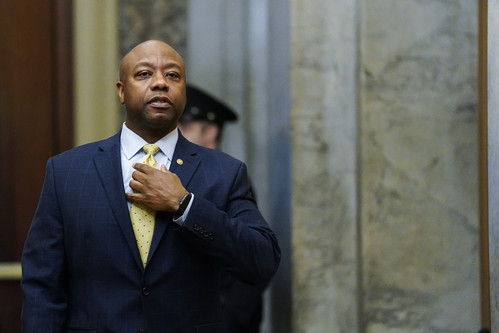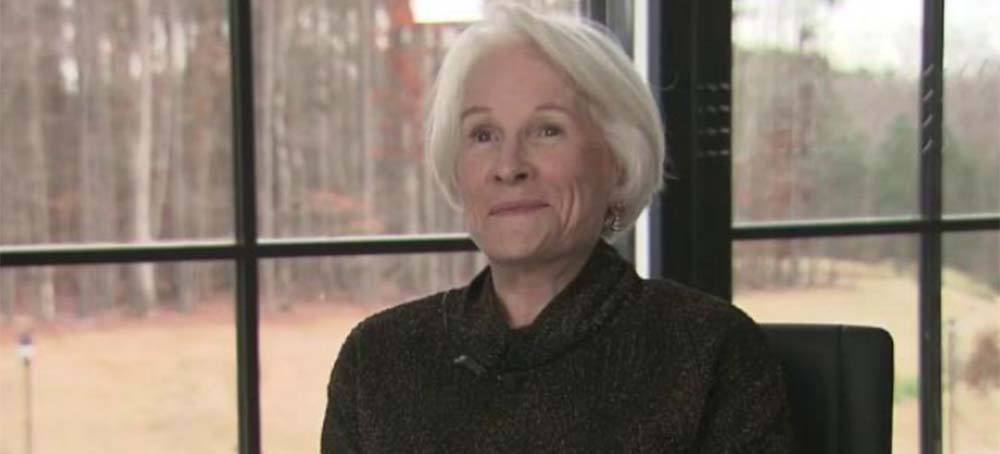
12 December 22
Live on the homepage now!
Reader Supported News
CAN ANYONE DONATE A THOUSAND? — Year-end fundraising like all other forms of fundraising is becoming harder each year. What was reliable is now far from certain. It is an uphill battle, absolutely. Is there someone who can match the smaller donations with a $1,000 contribution? It would mean a great deal.
Marc Ash • Founder, Reader Supported News
Sure, I'll make a donation!

Dan Rather and Elliot Kirschner | So Long Sinema?
Dan Rather and Elliot Kirschner, Steady
Excerpt: "A senator leaves her party."
It was only a few days ago that Democrats were cheering Raphael Warnock’s big win in the Georgia Senate race. Now the party wakes up this Friday morning to ... Kyrsten Sinema.
The breaking news is that Sinema, who has long been a thorn in the side of Senate Democrats with her inscrutable demands and frustrating voting patterns, is leaving the party. She says she’s not becoming a Republican but an “ independent.” What exactly that means remains to be seen.
Suddenly the 51-49 Democratic majority in the Senate looks a little different, but how different? The majority already included two independents who caucus with the party and are reliable votes — Bernie Sanders of Vermont and Angus King of Maine. Will Sinema be in that mold? Her tenure thus far suggests she will be much more problematic for Senate Majority Leader Chuck Schumer. But how much?
Sinema says this is all about her being an independent-minded moderate who feels out of place in either party because they are being pulled to the extremes. But as many are already noting, this might be a lot more about trying to secure a path to reelection in 2024. It was almost certain that Sinema would face a primary challenger if she had remained a Democrat. The young Arizona Congressman Ruben Gallego, who served in the Marines in the Iraq War, has made many statements that suggest he will run.
In the recent midterms, Democrats won big in Arizona, including Senator Mark Kelly, who won by nearly five points. Had Kelly lost or barely hung on, Sinema could have made the case that she would be the only Democrat who could win in 2024. That case is a lot harder to make now. The politics of the state are clearly shifting. Running as an independent allows her to skip a primary.
That brings up the question of what might happen in the general election. Would she split the vote and deliver the seat to a Republican? Would her candidacy falter, especially if Gallego runs and attracts enthusiasm from young and minority voters? These are the questions that will be debated by political strategists over the next two years.
In the meantime, it is useful to pull out a bit and ask what insights these developments give to our current political era. There was a time when the ranks of Senate Democrats were full of people like Sinema. They were difficult to wrangle, liked to position themselves as moderates, and often frustrated party leaders. Just think back to the sausage making over Obamacare.
But let’s use Senator Warnock now as a comparison. He is not a firebrand in the way he speaks. He is willing to work across the aisle, a fact he liked to highlight during his recent campaign. But he is also not apologetic about his progressive beliefs. He is a pragmatic progressive. And he won in a state where Republicans otherwise did very well in 2022. Some of that was clearly his opponent, but it would do Warnock a grave disservice to diminish his political skills.
There are other senators like him, especially among the younger cohort in the caucus. There is a growing determination and progressive energy among Senate Democrats. Just look at how much they were able to accomplish in the last Congress with the slimmest majority possible. Sinema seems anachronistic, especially coming from a state trending blue like Arizona. Joe Manchin also seems cut from that mold, but he is representing West Virginia, a state Trump won by nearly 40 points in 2020.
It is pretty clear that Manchin is the only person who could win in West Virginia as a Democrat these days. Perhaps Sinema told herself that was the case for her in Arizona. The election results tell a different story.
Sinema has gotten a lot of criticism from her constituents, and not only for her votes. She is seen as out of touch, providing few opportunities for public engagement. And she is seen as close to lobbyists and business interests. Back in 2018, Democratic activists worked tirelessly for her election and gave lots of money to her campaign. This feeling of betrayal will shape not only her future but the vetting of future candidates.
One suspects that going forward, Democrats will be looking for a lot more Warnocks and a lot fewer Sinemas. Even in purple states. Maybe especially in purple states.
READ MORE
 Senator Bernie Sanders (I-Vt.) (photo: Getty Images)
Senator Bernie Sanders (I-Vt.) (photo: Getty Images)
Sanders: Sinema Is Just a ‘Corporate Democrat’ Who ‘Sabotaged Enormously Important Legislation’
Peter Wade, Rolling Stone
Wade writes: "When asked if Sinema has the guts to take on powerful special interests, Sanders replied, 'No. She doesn't.'"
When asked if Sinema has the guts to take on powerful special interests, Sanders replied, "No. She doesn't"
Sen. Bernie Sanders is not excited that there is another independent in the U.S. Senate. Speaking about Sen. Kyrsten Sinema’s recent defection from the Democratic Party, Sanders seemed underwhelmed. “She’s a corporate Democrat who has… sabotaged enormously important legislation,” he said.
“I don’t want to spend a whole lot of time on Sen. Sinema. She has her reasons,” Sanders told host Dana Bash on CNN’s State of the Union. “I happen to suspect that it’s probably a lot to do with politics back in Arizona. I think the Democrats there are not all that enthusiastic about somebody who helped sabotage some of the most important legislation that protects the interests of working families and voting rights and so forth.”
Sinema has been a near constant irritant for Democrats in the Senate as she slowed or blocked important pieces of legislation. Arizona Democrats have been openly critical of Sinema and even censured her for blocking filibuster reform that would have allowed Democrats to pass historic legislation to protect voting rights. Sinema drew criticism from Democrats nationally when she delayed Biden’s Build Back Better bill over her objections to increases in the corporate tax rate — opposition Democrats told Rolling Stone they believed was “inauthentic.” She has even earned praise from the opposing party. GOP Minority Leader Sen. Mitch McConnell, called her the “most effective first-term senator” he’s ever seen.
Continuing his thoughts on Sinema’s defection, Sanders added, “I think [her leaving the Democratic Party] really has to do with her political aspirations for the future in Arizona. But for us, I think, nothing much has changed in terms of the functioning of the U.S. Senate. The good news is that we now have 51 votes, we’ll have the majority on committees. It means we can go forward and start protecting the interests of working families and deal with the reality that we are increasingly living in an oligarchy where the billionaire class and large corporations control almost every aspect of our country.”
When Bash asked whether Sanders would support a Democrat running against Sinema in 2024 when her term ends, the senator said he supports “people who have the guts to take on powerful special interests.”
Bash next asked if Sanders believes that Sinema has the guts to take on powerful special interests. “No. She doesn’t,” he said. “She’s a corporate Democrat who has, in fact, along with Sen. Manchin, sabotaged enormously important legislation.”
READ MORE
 Policemen looking at the wreckage of the 747 Pan Am airliner that exploded over Lockerbie, Scotland, in 1988. (photo: Roy Letkey/AFP/Getty Images)
Policemen looking at the wreckage of the 747 Pan Am airliner that exploded over Lockerbie, Scotland, in 1988. (photo: Roy Letkey/AFP/Getty Images)
Libyan Operative Charged in 1988 Lockerbie Bombing Is in FBI Custody
Adam Goldman, The New York Times
Goldman writes: "Abu Agila Mohammad Mas’ud, a Libyan bomb expert, is accused of building the explosive device used in the bombing of Pan Am Flight 103."
Abu Agila Mohammad Mas’ud, a Libyan bomb expert, is accused of building the explosive device used in the bombing of Pan Am Flight 103.
ALibyan intelligence operative charged in the 1988 bombing of an American jetliner over Lockerbie, Scotland, was arrested by the F.B.I. and is being extradited to the United States to face prosecution for one of the deadliest terrorist attacks in American history, officials said on Sunday.
The arrest of the operative, Abu Agila Mohammad Mas’ud, was the culmination of a decades-long effort by the Justice Department to prosecute him. In 2020, Attorney General William P. Barr announced criminal charges against Mr. Mas’ud, accusing him of building the explosive device used in the bombing of Pan Am Flight 103, which killed 270 passengers, including 190 Americans.
Mr. Mas’ud faces two criminal counts, including destruction of an aircraft resulting in death. He was being held at a Libyan prison for unrelated crimes when the Justice Department unsealed the charges against him two years ago. It is unclear how the U.S. government negotiated the extradition of Mr. Mas’ud.
Mr. Mas’ud’s suspected role in the Lockerbie bombing received new scrutiny in a three-part documentary on “Frontline” on PBS in 2015. The series was written and produced by Ken Dornstein, whose brother was killed in the attack. Mr. Dornstein learned that Mr. Mas’ud was being held in a Libyan prison and even obtained pictures of him as part of his investigation.
“If there’s one person still alive who could tell the story of the bombing of Flight 103, and put to rest decades of unanswered questions about how exactly it was carried out — and why — it’s Mr. Mas’ud,” Mr. Dornstein wrote in an email after learning Mr. Mas’ud would finally be prosecuted in the United States. “The question, I guess, is whether he’s finally prepared to speak.”
After Col. Muammar el-Qaddafi, Libya’s leader, was ousted from power, Mr. Mas’ud confessed to the bombing in 2012, telling a Libyan law enforcement official that he was behind the attack. Once investigators learned about the confession in 2017, they interviewed the Libyan official who had elicited it, leading to charges.
Even though extradition would allow Mr. Mas’ud to stand trial, legal experts have expressed doubts about whether his confession, obtained in prison in war-torn Libya, would be admissible as evidence.
Mr. Mas’ud, who was born in Tunisia but has Libyan citizenship, was the third person charged in the bombing. Two others, Abdel Basset Ali al-Megrahi and Al-Amin Khalifa Fhimah, were charged in 1991, but American efforts to prosecute them ran aground when Libya declined to send them to the United States or Britain to stand trial.
Instead, the Libyan government agreed to a trial in the Netherlands under Scottish law. Mr. Fhimah was acquitted and Mr. al-Megrahi was convicted in 2001 and sentenced to life in prison.
In 2009, Scottish officials released Mr. al-Megrahi because he had prostate cancer, despite the strenuous objections of the families of the victims and of American officials, including President Barack Obama. Mr. al-Megrahi died in 2012; his family posthumously appealed his conviction in Scotland, but last year a panel of judges refused to overturn it.
Prosecutors say that Mr. Mas’ud played a key role in the bombing, traveling to Malta and delivering the suitcase that contained the bomb used in the attack. In Malta, Mr. Megrahi and Mr. Fhimah instructed Mr. Mas’ud to set the timer on the device so it would blow up while the plane was in the air the next day, prosecutors said.
On the morning of Dec. 21, 1988, Mr. Megrahi and Mr. Fhimah met Mr. Mas’ud at the airport in Malta, where he turned over the suitcase. Prosecutors said Mr. Fhimah put the suitcase on a conveyor belt, ultimately ending up on Pan Am Flight 103.
Mr. Mas’ud’s name surfaced twice in 1988, even before the bombing took place. In October, a Libyan defector told the C.I.A. he had seen Mr. Mas’ud at the Malta airport with Mr. Megrahi, saying the pair had passed through on a terrorist operation. Malta served as a primary launching point for Libya to initiate such attacks, the informant told the agency. That December, the day before the Pan Am bombing, the informant told the C.I.A. that the pair had again passed through Malta. Nearly another year passed before the agency asked the informant about the bombing.
But investigators never pursued Mr. Mas’ud in earnest until Mr. Megrahi’s trial years later, only for the Libyans to insist that Mr. Mas’ud did not exist. Mr. Megrahi also claimed he did not know Mr. Mas’ud.
READ MORE
 Rupert Murdoch, center, stands with sons Lachlan and James Murdoch. (photo: Dan Steinberg/AP)
Rupert Murdoch, center, stands with sons Lachlan and James Murdoch. (photo: Dan Steinberg/AP)
Fox News: Is Dominion's $1.6 Billion Defamation Lawsuit a Death Blow for Murdoch Channel?
Chris McGreal, Guardian UK
McGreal writes: "Rupert Murdoch rarely has to answer for the alternative realities presented by his hugely profitable US cable network, Fox News."
The media mogul and Fox Corp are being sued for allegedly broadcasting ‘lies’ about the voting machine company
Rupert Murdoch rarely has to answer for the alternative realities presented by his hugely profitable US cable network, Fox News.
Its conspiratorial claims of a parade of cover ups from the 2012 Benghazi attack to the climate crisis and Covid-19 have been lapped up by Fox viewers and scorned by much of the rest of America, and then the world moved on. But on Tuesday, the 91-year-old billionaire media mogul will be obliged to answer difficult questions under oath about the inner workings of Fox.
Dominion Voting Systems is suing the cable news station and its Murdoch-owned parent company, Fox Corp, for $1.6bn (£1.3bn) over repeated claims that it rigged its voting machines as part of a conspiracy to steal the 2020 presidential election from Donald Trump.
The suit shines a spotlight on Fox News’ part in promoting Trump’s “stop the steal” campaign and its hand in driving the January 6 insurrection at the Capitol. But legal experts say that Dominion, which supplied voting machines to 28 states, appears to be building a wider case that Fox News has a long history of misinformation and steamrolling facts that do not fit its editorial line.
Over the past few months, Dominion’s lawyers have been working their way up the tree of Fox News producers, executives and presenters with interrogations under oath about the network’s work culture and its weeks of conspiratorial, and at times outlandish, claims about Trump’s defeat. On Monday, lawyers deposed Murdoch’s eldest son, presumed successor and Fox Corp CEO, Lachlan.
Now, Dominion has reached the top of the tree. Months of accumulated testimony are expected to put Murdoch, the chair of Fox Corp, in the difficult position of either having to deny he has control over what happens at his most influential US news operation or defend its campaign to promote the biggest lie in US electoral history.
Murdoch is already grappling with the costly legacy of phone hacking by British newspapers the News of the World and the Sun. His UK company has paid more than £1bn ($1.2bn) over the past decade to keep the gruesome details from being heard in open court with no end in sight after a high court judge earlier this year refused to prevent the filing of new claims.
When Murdoch was called to give evidence to a UK parliamentary hearing in 2011 about News of the World hacking the phones of a murdered schoolgirl as well as hundreds of politicians, celebrities and other public figures, he said that it was the most humble day of his life. He also claimed to have known nothing about the wrongdoing and said that he had been misled.
“I feel that people I trusted … I’m not saying who … let me down and I think they behaved disgracefully,” he told parliament. “And it’s time for them to pay.”
But he can make no such claim about Fox News, where its misrepresentations were on full display. So far, the only people to pay at the network are the ones who got it right.
The trouble started on election night after Fox called the key swing state of Arizona for Joe Biden. The call drew Trump’s ire and unleashed a backlash against the network from his supporters.
At that point, Fox News CEO Suzanne Scott warned against bowing to pressure to embrace an alternate reality and reverse the Arizona call.
“We can’t give the crazies an inch,” she said, according to court records.
As it turned out, “the crazies” took a mile, as Fox News put a parade of Trump lawyers, advisers and apologists front and centre over the following weeks to promote a myriad of conspiracy theories about how the election was stolen from Trump, including by rigging the voting machines.
Alongside them, some of Fox’s biggest names took up the cry of fraud. NPR revealed that during the discovery process, Dominion acquired an email written by a Fox News producer begging colleagues not to allow one of those presenters, Jeanine Pirro, on the air because she was spreading conspiracy theories about the vote. Pirro, a former district attorney and judge who is close to Trump, continued broadcasting.
Lawyers have also obtained rafts of internal messages that are “evidence that Fox knew the lies it was broadcasting about Dominion were false” and part of a culture of politically loaded reporting and broadcasts far from the network’s claim to be “fair and balanced”.
Dominion claims that without Fox, “these fictions” about electoral fraud would never have gained the same traction among large number of Americans.
“Fox took a small flame and turned it into a forest fire,” the company claims in its lawsuit.
In August, lawyers questioned another presenter, Sean Hannity, who has been described as “part of Trump’s campaign apparatus”. He was grilled for more than seven hours including about a broadcast two weeks after the presidential election in which Trump lawyer and conspiracy theorist Sidney Powell was a guest.
Powell claimed that Dominion “ran an algorithm that shaved off votes from Trump and awarded them to Biden”. She said the company “used the machines to inject and add massive quantities of votes for Mr Biden”. Powell has also claimed that Dominion used software developed to help the late Venezuelan leader Hugo Chávez steal elections.
Dominion has said that it warned Fox News that such claims were false but that it continued to air them in an attempt to assuage Trump supporters out of concern they would move to other right-wing broadcasters.
“It’s an orchestrated effort,” Dominion’s lawyer told a court hearing. “It’s not just on the part of each host individually, but it’s across Fox News as a company.”
So far the only Fox employees to pay a price for the debacle are those who got it right. Weeks after the election, the network fired its political director, Chris Stirewalt, who had infuriated Trump and other Republicans by refusing to back down from calling Arizona for Biden. The Washington managing editor, Bill Sammon, who supported Stirewalt’s decision, took retirement.
Fox argues that Hannity and the other presenters are protected by journalistic privilege but that position has been complicated by the Fox host’s own description of his role.
In defending his overt bias in favour of Trump and Republicans, Hannity has more than once said he is not a journalist but a talk show host, and so does not have to adhere to the profession’s ethical standards. He took the same position earlier this year after the January 6 congressional committee exposed dozens of his messages to Trump’s chief of staff, Mark Meadows, offering advice and seeking direction as the White House challenged the presidential election result.
READ MORE
 Impellizeri, left, and his officers at a fatal overdose at Mission Beach in San Diego on Nov. 12. (photo: Salwan Georges/WP)
Impellizeri, left, and his officers at a fatal overdose at Mission Beach in San Diego on Nov. 12. (photo: Salwan Georges/WP)
Cause of Death: Washington Faltered as Fentanyl Gripped America
Nick Miroff, Scott Higham, Steven Rich, Salwan Georges and Erin Patrick O'Connor, The Washington Post
Excerpt: "During the past seven years, as soaring quantities of fentanyl flooded into the United States, strategic blunders and cascading mistakes by successive U.S. administrations allowed the most lethal drug crisis in American history to become significantly worse, a Washington Post investigation has found."
During the past seven years, as soaring quantities of fentanyl flooded into the United States, strategic blunders and cascading mistakes by successive U.S. administrations allowed the most lethal drug crisis in American history to become significantly worse, a Washington Post investigation has found.
Presidents from both parties failed to take effective action in the face of one of the most urgent threats to the nation’s security, one that claims more lives each year than car accidents, suicides or gun violence. Fentanyl is now the leading cause of death for Americans ages 18 to 49.
The Drug Enforcement Administration, the country’s premier anti-narcotics agency, stumbled through a series of missteps as it confronted the biggest challenge in its 50-year history. The agency was slow to respond as Mexican cartels supplanted Chinese producers, creating a massive illicit pharmaceutical industry that is now producing more fentanyl than ever.
The Department of Homeland Security, whose agencies are responsible for detecting illegal drugs at the nation’s borders, failed to ramp up scanning and inspection technology at official crossings, instead channeling $11 billion toward the construction of a border wall that does little to stop fentanyl traffickers.
The White House Office of National Drug Control Policy, the executive branch office headed by the “drug czar” and tasked with coordinating the government’s response, spent years fending off elimination and struggled to create an effective strategy to combat the scourge. The office lost its seat in the White House Cabinet and remains sidelined.
“Law enforcement did the best it could,” said David King, executive director of a federal drug task force in San Diego. “We can only do so much. But in Washington, they have been very slow to respond to this and now we are at the confluence of paralysis.”
The DEA said it is now taking direct aim at the Mexican cartels and the fentanyl epidemic. DEA Administrator Anne Milgram acknowledged that the government remained too focused on heroin at the onset of the crisis, as Mexican traffickers ramped up production of synthetic opioids.
“It is a new, deeper, more deadly threat than we have ever seen, and I don’t think that the full extent of that harm was immediately seen in 2015,” she said.
Narcotics agents say street-level demand for fentanyl is rising fast because so many new users are getting hooked. More than 9 million Americans “misused opioids” in 2020, according to the latest estimates by the Department of Health and Human Services. But the agency has not tracked the rise of fentanyl and does not know how many Americans are using it.
The Centers for Disease Control and Prevention is unable to track overdose deaths in real-time. Its published data is one year behind, obscuring the picture of what is happening on the ground in 2022. The agency continues to count the death toll for 2021 — in a provisional tally seven months ago, it calculated the overall number of drug overdoses at 107,622. Two-thirds were due to fentanyl.
When President Richard M. Nixon launched America’s first war on drugs 51 years ago, annual overdose deaths stood at 6,771.
There is one federal system that collects both fatal and nonfatal overdose data in real-time in several regions of the country. But the system, called ODMAP, is kept from public view. A database launched by the drug czar’s office last week maps some nonfatal overdoses, which can highlight regions where deaths are likely to follow.
Without comprehensive data, the federal government is driving blind.
“This is like tracking the epidemic by visiting cemeteries,” said John P. Walters, who served as drug czar during the Clinton and George W. Bush administrations. “We’re not measuring what’s coming into the country in real-time. We’re not measuring what’s happening with the health consequences and where to put resources to buffer those health consequences. Our drug-control strategy is an embarrassment, and it doesn’t begin to propose a way of reversing this problem.”
The American fentanyl crisis deepened during the coronavirus pandemic. From 2019 to 2021, fatal overdoses surged 94 percent, and an estimated 196 Americans are now dying each day from the drug — the equivalent of a fully loaded Boeing 757-200 crashing and killing everyone on board.
Ed Byrne knows better than anyone the cost of fentanyl on U.S. streets. Byrne, 54, a Homeland Security Investigations agent in San Diego, has kept his own count of the nearly 500 fatal overdoses he has witnessed. It was a way to impose some order on the snowballing disaster.
“It is so much useless death,” said Byrne, who began investigating fentanyl cases in 2018.
San Diego is ground zero for fentanyl trafficking into the United States. More than half of all the fentanyl seized along the southern border is confiscated there, much of it produced in clandestine drug labs and pressed into tablets by cartel networks in northern Mexico. Drug loads that cross the border undetected go to stash houses in Los Angeles and Phoenix before spreading eastward across the country. In Southern California, the cartels are renting Airbnbs to store drugs before shipping them across the country.
Byrne tracked fentanyl shipments as a key member of Team 10, a multiagency task force specializing in the drug. At death scenes, Byrne tested pills and powder and fingernails, a job that took him to $10 million mansions, rental apartments and homeless camps. Sometimes he went to suburban homes to find teenagers dead in their childhood bedrooms.
For all of Team 10’s success in catching dealers, the drugs and the overdoses kept coming. San Diego County tallied 92 fentanyl-related deaths in 2018, the year the task force was formed. Last year, there were 814.
Byrne and his colleagues printed hats and T-shirts with their own logo for Team 10: a lone wolf, howling into a void.
The roots of the epidemic reach back to the Bush administration, which did little as countless Americans became addicted to oxycodone and other prescription opioids while U.S. drug manufacturers, distributors and chain pharmacies made billions in profits.
During the Obama administration, amid a wider questioning of the U.S. criminal justice system, the government defunded and dismantled key drug-monitoring programs in the years before fentanyl hit. President Barack Obama demoted the White House drug czar position, removing the role from the Cabinet. And when heroin use rose after the government crackdown on prescription opioids, authorities treated fentanyl as an additive, rather than a distinct threat requiring its own specific strategy.
President Donald Trump took office just as the fentanyl epidemic was about to explode. He promised to build a wall along the U.S. southern border that he said would stop drugs. But Mexican traffickers were sneaking fentanyl right through the front door, hidden in passenger vehicles and commercial trucks passing through official ports of entry in California and Arizona. Today, the partisan border debate in Washington remains fixated on a physical structure that is virtually useless for stopping the deadliest drug U.S. agents have ever faced.
Since President Biden took office, his administration has amplified a public messaging campaign to warn about fentanyl’s mortal threat — “One Pill Can Kill.” He has stepped up efforts to improve scanning technology at border crossings and repair a broken counternarcotics partnership with Mexico. But with Republicans blaming Biden’s border policies for record numbers of immigration arrests, the president and many of his top officials have said little about the skyrocketing amount of fentanyl entering the country.
When the U.S. government cracked down on the U.S. opioid industry starting in 2005, it choked off street supplies of prescription narcotics but left behind a ravenous market. Mexican cartels filled it, first with crude heroin, then fentanyl. The cartels imported drugs and chemicals from China, hired chemists and purchased pill presses. But at the moment when the federal agencies responsible for preventing the drug from gaining a foothold in America were needed most, they fell short.
The amount of fentanyl seized along the U.S. southern border — the most reliable gauge of supply — has jumped ninefold during the past five years. Since July, border seizures of fentanyl have averaged 2,200 pounds a month, meaning U.S. authorities are confiscating more fentanyl in a single month than they did during all of 2018. Federal officials estimate they are capturing 5 to 10 percent of the fentanyl crossing from Mexico, but they acknowledge it could be less.
The drug is cheaper than ever because supplies are so abundant. On the streets of U.S. cities in the early 2000s, the most popular prescription pain pill was made by Mallinckrodt Pharmaceuticals, one of the nation’s oldest drug manufacturers. The company’s 30-milligram oxycodone tablets, known as “blues” or “M-30s,” sold for roughly $30 apiece on the black market. Today, fake M-30s made by Mexican cartels using fentanyl look identical but sell for $4 or $5 apiece on the streets of San Diego, and can be especially lethal to first-time users.
Byrne had been to 486 death scenes by the time his bosses decided he’d seen enough. They sent him this summer on a new assignment in the South Pacific. As he prepared to leave San Diego, the narcotics agents and prosecutors who worked with him threw a farewell party at the Tin Roof, a honky-tonk bar downtown in the city’s renovated Gaslamp Quarter.
“I can’t say we made progress,” said Sherri Walker Hobson, a tough, laser-focused former federal prosecutor who worked closely with Byrne, raising a toast to her best friend as the bar went quiet. “But we put up a good fight. We did the best we could to manage this.”
San Diego’s Gaslamp Quarter is lined with pricey new restaurants and old-style saloons that evoke the city’s history. They share the streets with thousands of people sleeping in tents and alleys, many gripped by addiction.
A few stood outside the Tin Roof, just beyond the sidewalk tables, on the night of Byrne’s farewell. At one point, a grubby, disheveled man with bulging eyes walked into the party and sat down among the cops. He didn’t speak, but he appeared to be under the influence of something powerful.
When one of the bartenders noticed and came onto the floor to confront him, the man ran to the back of the restaurant. Two of the plainclothes narcotics officers from Byrne’s party followed. They shooed the man out of the bar and back onto the street.
‘China, China, China’
By 2017, fentanyl had become the leading cause of overdose deaths in America. For three years, Hobson, then an assistant U.S. attorney in San Diego, had been tracking the steady rise in fentanyl seizures at the busiest land port in the nation — San Ysidro, 20 miles south of downtown San Diego. Fentanyl deaths had quadrupled in San Diego County between 2014 and 2017.
In the spring of 2017, Hobson formed the Fentanyl Working Group, a collection of federal and state drug agents, prosecutors and chemists, along with the medical examiner and other public health officials. It amounted to an emergency summit. Byrne joined the cause. They were hoping for a turnout of 15 people. Forty showed up.
The group began to collect drug overdose and seizure data and quickly realized that the doses of fentanyl that had been causing so many deaths in San Diego and across the country were coming from cartels in Mexico, not from traffickers in China.
“China was in the rearview mirror,” Hobson said.
Hobson and her colleagues tried to spread the word. They launched a local public awareness campaign. They created fact sheets and PowerPoint presentations to alert law enforcement agencies in the region. Hobson traveled the country, speaking at national drug policy conferences, where she sounded the alarm about the flood of fentanyl coming from Mexico.
From 2016 to 2017, fentanyl seizures at California’s ports of entry rose by 266 percent, from 573 pounds to 2,099. Most involved counterfeit M-30 pills. At the time, 2.2 pounds of fentanyl cost about $40,000. That amount could be turned into 1 million pills, netting the cartels millions in profit.
Hobson knew how the cartels operated because she had been prosecuting methamphetamine cases since the 1990s. The San Diego region had been a hub for small-batch, U.S.-made “biker meth.” Then Mexican traffickers figured out how to cook it cheaper, and make it purer. They put competitors north of the border out of business.
“I think a lot of people underestimated the Mexican cartels,” Hobson, who retired in 2020 after 30 years with the U.S. attorney’s office in San Diego, said in a recent interview. “I knew they were very innovative. They weren’t hesitant to adapt and try new things.”
Outside San Diego, Hobson’s warnings went largely unheeded.
The importation of fentanyl from Mexico was not the focus of the Trump administration. In October 2017, a Justice Department official said in an op-ed column that “most illicit fentanyl and fentanyl analogues come from China.”
The department announced an indictment against Chinese nationals, furthering the narrative that China was paramount. Reading through the indictment, Hobson realized that the allegations were old, dating back to 2014 and 2015. By 2017, it was clear to Hobson and members of the Fentanyl Working Group that the supply lines had shifted.
“There was so much focus on China, they didn’t look at where the ball was,” Hobson said. “They weren’t looking at the cartels in a serious way. It was all about China, China, China.”
‘A game changer’
Byrne caught a case in 2017 that confirmed the lightning-fast rise of the Mexican cartels. On Aug. 11, a U.S. Customs and Border Protection officer stationed at Los Angeles International Airport intercepted a package from China containing a chemical called 4-ANPP, a precursor used to make fentanyl. Byrne and Hobson, along with agents from the DEA and the U.S. Postal Inspection Service, devised a plan.
The team replaced the precursor with a bag of sand, put a tracking device on the package and followed it to San Diego. It was delivered to a post office box near the border linked to a man named Cesar Daleo. Byrne recognized the name from his days working as a U.S. Border Patrol agent before he joined Homeland Security Investigations. Daleo was once a Border Patrol agent, too.
The team members decided to allow Daleo to pick up the parcel. It would be the 14th time that he had signed for such a package since 2016. They hoped Daleo would take the interstate off-ramp from San Ysidro into Mexico. If he took the bait and drove onto the ramp, he would be making a commitment to entering Mexico. The team could then prove in court that the precursor chemicals were bound for the cartels.
On Aug. 29, 2017, Daleo picked up the parcel and opened the box, severing a hairline surveillance wire and sounding an alarm to the team. He tossed the box containing the bag of sand into his trunk and headed south, taking the off-ramp to Mexico. A Homeland Security tactical team cut him off. One of the agents tossed a stun grenade at Daleo’s car. He crashed into a guardrail. The agents smashed Daleo’s driver’s side window, dragged him through it onto the ramp and carted him off in handcuffs.
Daleo later pleaded guilty to drug conspiracy charges and was sentenced to 30 months in prison. For the first time, Byrne and Hobson had unassailable proof that the cartels were making their own fentanyl and cutting out the middlemen.
“It was a game changer,” Byrne said.
But in Washington, fentanyl was barely registering on the radar screen.
That year, the DEA published a 94-page resource document that devoted four pages to synthetic opioids. It made no mention that Mexican traffickers were producing fentanyl. Under “Drugs of Concern,” fentanyl was not listed. In the DEA’s 2017 National Drug Threat Assessment, the agency devoted 10 of 169 pages to fentanyl and other synthetic opioids. U.S. law enforcement agencies surveyed by the DEA identified heroin as the greatest threat facing the nation, followed by meth and prescription drugs. Fentanyl came in fourth, slightly ahead of marijuana.
There were other missteps. In the years before fentanyl hit the streets, crucial programs to monitor drug use were dismantled.
One, the Arrestee Drug Abuse Monitoring Program, gathered urine samples from recent offenders. The program, run by the White House drug czar, was scuttled in 2013 by budget cuts.
The Drug Abuse Warning Network, which collected drug use and overdose data from hospitals and emergency responders, was eliminated in 2011. The government brought back a version of the program in 2018, but by then, the fentanyl crisis was well underway.
“These programs, as imperfect as they were, at least gave us something. And they were defunded,” said Keith Humphreys, who served as a drug policy adviser to the George W. Bush and Obama administrations.
Soon after Trump became president, his administration proposed eliminating the drug czar’s office entirely. It became a backwater for political appointees, many of them with scant or no drug policy expertise. A 23-year-old Trump campaign worker was named deputy chief of staff, but no one had been nominated to head the office. Nearly nine months into his presidency, Trump selected Rep. Tom Marino (R-Pa.) — a former federal prosecutor and one of Trump’s first and most strident supporters in Congress — to be drug czar. But Marino soon withdrew his nomination after it was revealed in a joint Washington Post-“60 Minutes” investigation that he had co-sponsored legislation that made it more difficult for the DEA to hold drug manufacturers, distributors and pharmacies accountable when they violated federal law.
As the Trump administration was preparing to leave the White House in 2021, the drug czar’s office issued its annual National Drug Control Strategy to Congress. The document is supposed to detail the government’s plan to reduce drug demand and disrupt supply chains. But the 2021 strategy document was nearly identical to the one issued in 2020. Many of its sections had simply been copied from the previous year.
‘Hold people accountable’
One name on the medical examiner’s list of 2017 overdose deaths in San Diego is Leo Holz. The cause of death was “fentanyl toxicity.” His age: “zero.”
Leo was 10 months old. He was crawling around on the bed between his sleeping parents. Leo picked up a bright blue pill and put it in his mouth. When his parents woke up, their baby was cold and unresponsive.
Leo was the youngest person in San Diego to die because of fentanyl. Since then, the drug has killed two other children there before their first birthdays.
Byrne and Hobson investigated the Holz case, tracing the pills to a drug ring that included a U.S. citizen in Tijuana named April Spring Kelly. She told prosecutors she used heavyset women as “body carriers,” because they were less likely to be patted down, and sent them through Arizona and California crossings.
Couriers were smuggling packages taped to their thighs and abdomens, or in body cavities. “Stuffers,” as the agents called them, could sneak a pound of pills or powder through a port of entry. Kelly admitted in a plea agreement to smuggling nearly half a million fentanyl pills across the border. She was sentenced to 14 years.
The Trump administration was less focused on drugs than immigration. Trump officials were preparing to award contracts worth billions of dollars for the president’s border wall, and they invited construction firms to set up side-by-side prototype designs on a dusty lot near the Otay Mesa crossing, 27 miles south of downtown San Diego. The region was a natural choice. The fencing CBP had installed along the border there over the previous two decades was more formidable than anywhere else.
What Trump officials didn’t acknowledge was that the barriers made little difference to the cartels: The place with the mightiest fence was also the traffickers’ primary gateway for hard drugs.
“The cartels saw the void left by the U.S. pharmaceutical industry,” said John Callery, a 30-year veteran of the DEA who retired after running the San Diego field office. “Nature abhors a vacuum and they said, ‘Holy crap. We only have to get five pounds of fentanyl across the border instead of 7,000 pounds of meth. Perfect. And we can make 10 times as much money.’”
In the summer of 2018, a hard-charging local prosecutor in San Diego named Terri Perez proposed setting up Team 10 to investigate every fentanyl death and trace the drugs to the dealers. The team was headquartered at the DEA’s San Diego field office, and staffed by federal and local law enforcement officers from across the region.
“I had never seen anything like this. It’s impacting people from their early teens to their 40s and 50s, families being destroyed, parents losing their kids, schools losing their students,” Perez said. “We needed to hold people accountable.”
Perez turned to Byrne. He started to investigate dozens of overdose deaths, comforting family members while trying to gain access to the cellphones of the dead for leads.
Byrne and Hobson knew they were seeing only a small fraction of the drugs pouring across the border. And what they were hearing from DEA agents was not encouraging. Mexican President Andrés Manuel López Obrador was critical of his country’s drug war partnership with the United States and argued that it burdened Mexico unfairly and fueled violence.
Once López Obrador took office in December 2018, security and counternarcotics relationships with the United States had gone cold. He was distrustful of the DEA and the access U.S. agents had cultivated across the Mexican government.
In Washington, Trump had declared the opioid epidemic “a national health emergency” and pressured China to crack down on fentanyl shipments to the United States. But his administration’s focus at the border was to stop immigration. Trump, who falsely said Mexico would pay for the border wall, wanted the Democrats to provide $5 billion for the project. He shut down the government toward the end of 2018 when they wouldn’t give it to him.
The impasse ended after 35 days and led to a compromise on border security. Democrats agreed to furnish $1.4 billion for the wall. Republicans agreed to provide $564 million to add more-advanced “non-intrusive inspection” technology, known as NII, at the ports of entry.
“We asked: What would it take to stop the flow of drugs? Could we do a Manhattan Project for NII?” said a congressional staffer who worked closely on the funding plan but wasn’t authorized to speak publicly.
More than 228,000 cars and trucks were entering the United States each day from Mexico, but CBP officers were scanning only about 6 percent of commercial trucks and 1 percent of passenger vehicles.
Mexican traffickers were playing those odds, and winning. They could send the stuffers through the crossings, or just load the drugs into cars and trucks, and shrug off whatever losses they incurred as the price of doing business.
The border security plan that emerged in 2019 after the shutdown promised to change that calculus. Congressional appropriators set a goal for CBP to scan 72 percent of commercial trucks and 40 percent of passenger vehicles entering from Mexico.
To reach that objective, CBP needed software systems capable of processing the millions of images from the state-of-the-art scanning equipment. That required artificial intelligence to help agents quickly detect hidden compartments, altered engine parts and other anomalies.
The three-dimensional scans couldn’t find fentanyl buried deep in an engine block, but they could detect suspicious changes in densities. The drug loads show up as glowing bright spots because the X-rays pass through them so easily. CBP officers could route those vehicles to additional inspection.
“We gave them a huge pot of money,” the congressional staffer said. “We thought we had a good plan.”
The rising toll
After Byrne had responded to 100 fatal overdoses in San Diego, the pace suddenly picked up. Less than a year later, he was at his 200th death scene. Fentanyl was killing people in the most private and intimate of places — in their bedrooms, their bathrooms, in the hallways of their homes.
One of Byrne’s problems was that no one else wanted to test for fentanyl at crime scenes. In the early stages of the crisis, much of the DEA messaging had been geared toward alerting first responders to the dangers of fentanyl. They became so terrified that they would call in hazmat crews if they thought fentanyl was present.
But Byrne saw the downside to the scary messaging. Fentanyl is only a significant threat if the powder is dispersed into the air and inhaled. Touching the pills or handling bags of powder is not a mortal risk because the drug isn’t easily absorbed through the skin. Pharmaceutical fentanyl “patches” prescribed to manage intense pain use a chemical agent to allow the drug to be absorbed.
Fentanyl’s reputation made it hard for Byrne to get fellow officers and agents to do their own testing. So, they would call him, and he’d arrive in his Ford Explorer. In the back, he kept two MX908 mass spectrometers. He once found the crumbs of a pill under a dead teenager’s keyboard. The boy’s father hit the space bar, and when the monitor lit up, the boy’s message exchanges with the dealer popped up on the screen.
Sending samples to a lab that took weeks to process the results meant the loss of crucial time for investigative leads. And when a “hot,” or super-potent, supply was ravaging users in rapid succession, it was important to know right away that an especially lethal batch of fentanyl had hit the streets.
By 2019, fentanyl deaths in San Diego had risen 787 percent in five years.
“Just when we think it can’t get any worse, the latest numbers prove us wrong,” U.S. Attorney Robert Brewer said at a news conference that July.
That summer, Byrne responded to a call at an extended-stay motel in San Diego’s Clairemont Mesa district. A 30-year-old parolee named Major Williams, whom police had identified as a gang member, was found dead in his room. The cause of death: “fentanyl, cocaine and alcohol.”
Less than two years later, Byrne was back at the same motel to investigate another fentanyl death.
“It was the exact same room,” he said.
Glory days
During the 1980s and 1990s, DEA agents were seen as the rock stars of the law enforcement world, making major busts in the United States and helping to capture Latin American drug lords like Joaquín “El Chapo” Guzmán and Pablo Escobar.
The DEA has struggled during the past decade, losing nearly 1,300 staffers, 700 of them agents. Many agents retired early to take lucrative private-sector jobs. Today, the agency has more than 800 vacancies.
For six years, the DEA went without a Senate-confirmed administrator. Michele Leonhart, a 35-year veteran, announced her retirement in 2015 following revelations that DEA agents were attending sex parties with prostitutes hired by Colombian drug cartels.
Leonhart’s departure marked the beginning of a tumultuous time at the DEA. The agency went through five acting administrators, three of them during Trump’s tenure.
In 2018, DEA agent Fernando Gomez was charged with participating in a decade-long conspiracy to smuggle thousands of pounds of cocaine from Puerto Rico to New York. He was sentenced to four years in prison.
In 2020, DEA agent Jose Irizarry was accused of conspiring to launder money for a Colombian drug cartel while living a lavish lifestyle replete with wild yacht parties, bikini-clad prostitutes and homes in Cartagena, Colombia; Puerto Rico; and South Florida. He was sentenced to 12 years in prison.
More recently, a former agent, Manuel Recio, was accused of making payments to current agent John Costanzo Jr. in return for inside information about pending DEA cases. That information was then allegedly peddled to criminal defense attorneys hoping to recruit new clients. Recio and Costanzo could face more than 20 years in prison if convicted. They have denied the allegations.
A recent audit by the Justice Department’s Office of the Inspector General found that the DEA failed to effectively monitor its foreign offices and agents overseas. The DEA has ordered an outside review of the agency’s 92 foreign offices in 69 countries “to ensure integrity and accountability.”
Mark Coast, a retired DEA agent in San Diego who also spent 30 years as a Marine Corps reservist, said he saw the agency lose its operational muscle and strategic focus. “Everything is whack-a-mole,” he said in an interview. “A dealer pops up, they take that dealer out, and another one pops up.”
“There is no strategic plan,” he said.
Eighteen months ago, Milgram, a former New Jersey attorney general, became the first Senate-confirmed DEA administrator since 2015. She inherited the fentanyl crisis and has been scrambling to marshal a more robust response.
“This is not a war on drugs, this is a war to save lives,” she said in a recent interview at DEA headquarters in Northern Virginia, where the lobby walls are covered with more than 4,000 portraits of fentanyl overdose victims sent in by their families. They are almost entirely young faces, many of them in their teens and 20s.
“When you look at the faces, you have a sense of the enormity of what we’re losing,” Milgram said.
Since taking office, she has promoted the One Pill Can Kill campaign and begun targeting the two top Mexican cartels behind the flood of fentanyl — Sinaloa and Jalisco New Generation — going after their financial networks and global supply chains.
Between May and September, the DEA and other law enforcement agencies seized nearly 980 pounds of fentanyl powder and 10.2 million pills, and they investigated 380 fentanyl-related cases, connecting 35 directly to the two cartels. The DEA also investigated 129 cases of fentanyl ordered via social media platforms, including Snapchat, Facebook Messenger, Instagram and TikTok.
Milgram described the cartels’ push to expand markets by addicting more people as “deliberate, calculated treachery.”
Rahul Gupta, Biden’s drug czar and the first trained physician to hold that job, said in a recent interview that he is focused on flattening fentanyl’s death curve. He said he does not need the president to return his role to the Cabinet.
“The goal is really to address the crisis of today, not yesterday,” he said.
Gupta said the Biden administration is implementing a “harm reduction” approach that seeks to reduce deaths by supporting safe-use policies and expanding access to counseling and treatment. “Only 1 in 20 people who need the help are able to get it today in the United States of America,” he said.
Along the border, the administration is struggling to deploy the sophisticated scanning systems. Nearly four years after Congress gave the CBP money to expand inspections, new systems have been installed in Brownsville and Laredo, Tex., and at other border crossings. But they require officers to conduct labor-intensive reviews because the CBP lacks the ability to automate the process with artificial intelligence software and centralized command centers.
A House Appropriations Committee report published in June chastised the agency for its failures, saying it had a “paradigm-shifting opportunity” to “revolutionize” the inspection process. Instead, the strategy “continues to depend on CBP Officers to review thousands of images manually,” the report stated, calling it a shortsighted “failure to innovate” that is “inexcusable and must be immediately addressed by current DHS leadership.”
‘Just heartbreaking’
During a visit this fall to the medical examiner’s office in San Diego, 261 corpses in body bags were laid out on metal trays and stacked up on carts in the refrigerated morgue. Thirty-seven of the people had died of fentanyl overdoses. Fentanyl is now responsible for 1 in every 5 deaths handled by the San Diego County Medical Examiner’s Office. So many people are dying, it takes nearly four months to complete toxicology reports.
“It’s just heartbreaking,” said Medical Examiner Steven D. Campman, who reviewed 1,672 fentanyl-related deaths from 2014 through 2021.
“A fair number of families ask: ‘Shouldn’t I have done something? Couldn’t I have seen something?’ I tell them it shouldn’t be on them, and I can’t offer them much more.”
In October, after three months in the South Pacific, Byrne returned to San Diego. The city’s Deputy District Attorneys Association had named Byrne “Law Enforcement Officer of the Year” and invited him to pick up the award. Byrne looked 10 years younger, his face thinner and more tanned than when he had left San Diego.
After the awards ceremony, he went back to work. An old case among his 486 came to court for a sentencing hearing.
On Nov. 3, 2020, Sarah Elizabeth Fuzzell, 24, had been found dead in her apartment in Vista, Calif., 40 miles north of downtown San Diego. Byrne gained access to her phone. The drug dealer was unaware that one of his customers had just died. A Team 10 member texted the dealer, posing as Fuzzell on her phone. The man who had sold Fuzzell the fentanyl, Cole Salazar, fell for the ruse. Salazar was charged with selling the lethal dose.
The case took two years to wend its way through the courts. On Oct. 15, Byrne drove to the federal courthouse in downtown San Diego for Salazar’s sentencing. Fuzzell’s older sister, Megan, along with her mother, Mindy, had made the trip from their home in Oklahoma City. Megan, 30, was a medical researcher who had graduated magna cum laude from the University of Oklahoma and been a high school valedictorian and National Merit scholar. She volunteered at medical clinics to raise awareness about the dangers of drug overdoses.
Megan testified about the loss of her little sister.
“Since her death, I’m left with a hole in my heart that is irreparable and constantly present,” she told the judge. “I’m lost without her. My family feels incomplete and broken.”
That Wednesday evening, Byrne met Megan and Mindy for dinner in San Diego’s Little Italy. Even though the judge had sentenced Salazar to 10 years in prison, the mood was muted. The next night, the Fuzzells returned home to Oklahoma.
The following day, Byrne received a text message from Megan’s father.
“Mindy and I found Megan dead in her bed about 630 last night,” David Fuzzell wrote.
David and Mindy had lost their only remaining child. The autopsy results were still pending, but Byrne already knew. Megan was 487.
Six days later, he wrote to a Post reporter:
“I have been lucky to not have lost someone close to me in this battle, but I can sadly say I know all too well the heartbreaking sorrow of those who have. I accept Megan as 487. It impacted all of us from Sarah’s case like a knife in the gut. I still cannot speak with her mother. I know it’s not true but I somehow feel like I’ve failed the Fuzzells. How did we sit with her at dinner less than 48 hours before and not see or sense anything?
“In 2021, 107,000 souls were snuffed out from fentanyl in America. That number will be eclipsed this year. All the futures that have been lost, those still to be lost.
“Where’s the outrage?”
READ MORE
 Jana Zakarneh was shot dead on the roof of her family home. (photo: EFE/EPA)
Jana Zakarneh was shot dead on the roof of her family home. (photo: EFE/EPA)
Palestinian Girl Shot Dead on Roof of West Bank Home
Raffi Berg, BBC News
Berg writes: "The Palestinian health ministry said Jana Zakarneh was shot in the head by Israeli soldiers in Jenin on Sunday."
A 16-year-old Palestinian girl has been found shot dead on the roof of her home after a clash between Israeli forces and Palestinian gunmen in the occupied West Bank, Palestinian sources say.
The Palestinian health ministry said Jana Zakarneh was shot in the head by Israeli soldiers in Jenin on Sunday.
The Israeli military said it was aware of the report and was looking into it.
Zakarneh is one of the youngest Palestinians killed this year - the deadliest in the West Bank since 2005.
According to the Palestinian Authority's official Wafa news agency, Zakarneh's body was found by members of her family after soldiers had left the area following a raid.
Residents said they saw Israeli snipers positioned on a nearby building - one apparently shot the girl, the health ministry said.
Israeli public broadcaster Kan said a preliminary investigation by the Israel Defense Forces (IDF) found that an undercover unit fired at the roof where the teenager was standing after a shot was detected from there.
Kan cited IDF sources as saying the possibility that Zakarneh was hit by fire from Palestinian gunmen had not yet been ruled out. However, it said, the chance was low.
An IDF statement said its forces had fired towards armed suspects who had "hurled explosives and fired heavily" at them during an arrest raid.
Three people "suspected of terrorist involvement" were detained in the operation, it said.
Jana Zakarneh's death is the latest in a spiralling toll of Palestinian fatalities this year. In the West Bank, more than 150 - civilians, militant gunmen and armed attackers - have been killed, nearly all by Israeli forces.
The IDF has been carrying out near-nightly raids in the West Bank as part of an operation against militants which began in March after a wave of attacks in Israel by Palestinians and Israeli Arabs left 17 Israelis and two Ukrainians dead.
The spree of killings was the deadliest Israel had seen since 2015, leaving the country in shock.
The IDF has said that a total of 31 Israelis have been killed in attacks this year.
READ MORE
 'This is a really great sign of the health of wolves,’ says biologist Amaroq Weiss. (photo: California department of fish and wildlife)
'This is a really great sign of the health of wolves,’ says biologist Amaroq Weiss. (photo: California department of fish and wildlife)
'A Remarkable Sign': Flurry of Wolf Births Offers Hope for California Comeback
Katharine Gammon, Guardian UK
Gammon writes: "Grey wolves from Oregon may now be thriving in California, after vanishing more than a century ago."
Grey wolves from Oregon may now be thriving in California, after vanishing more than a century ago
In a year of environmental ups and downs, a hopeful story of recovery is afoot in California. A grey wolf pack gave birth to eight pups this spring, it was recently confirmed, offering signs of a remarkable comeback after wolves were wiped out in the state more than a century ago.
The births in the Whaleback wolf pack, based in northern California’s Siskiyou county, happened in the spring but were only confirmed by California’s department of fish and wildlife in November. They may be a sign that wolves who entered the state from Oregon several years ago are thriving.
“This is a really great sign of the health of wolves,” says Amaroq Weiss, a biologist who works as the senior wolf advocate for the Center for Biological Diversity. She says the scientific literature shows that wolves can have anywhere from two to 10 pups, but it’s pretty typical to have five or six. “The fact that eight pups have made it this far into the year is really exciting.”
Wolves were hunted to extinction in California a century ago. Then in the 1970s they gained protection under the Endangered Species Act, and wolves were slowly reintroduced to the Yellowstone area in Wyoming. From there, they began to do what wolves do: roam.
Wolves were never reintroduced in California, rather they came here because the living was good. Wolves from Yellowstone entered Oregon and eventually in 2011, OR-7 made his way into California. The state, with its dense forests, plentiful deer and other prey, and vast expanses of wilderness where roads don’t pose a fatal threat, is in many ways an ideal home.
“We used to have wolves here and now they are back, using the landscape and still producing offspring,” Weiss says.
Wolves in California are poised to thrive. In Oregon, the first wolves appeared in 1999 – but it wasn’t until 2008 that they had their first pack confirmed. Contrast that with California, Weiss says: the state has far fewer wolves, but they are making themselves at home faster. In 2015, the first pack was confirmed, and in 2017, the Lassen pack was established – and they have been having pups every year since.
The Whaleback pack was only confirmed in 2020, and had a litter in 2021 – and now a second in a row.
The state is typically careful about releasing numbers of pups – earlier this year, officials had confirmed the births of pups, but could only detect six in the litter. They use a combination of strategies to count the wolves, looking where collared wolves are spending time. Those locations usually point to the den site or the so-called rendezvous site, which is where pups are babysat by an older teen wolf while the parents are out hunting. When there’s a cluster of data in those spots, officials set up motion-activated cameras in the area and also collect scat – which can tell the age and sex of individuals, based on the size and DNA content. It takes some time, but it usually gives accurate counts, Weiss says.
Last year, the Whaleback pack had seven pups, and five are still with the family (it’s not known if the other two dispersed out to start their own packs or died). The wolf pups this year would have nursed for about five weeks and then were fed regurgitated meat from their parents. They start to go out with the pack at around six months old – just learning and watching, passing on their culture. They probably won’t participate in a hunt until they are a year old, and won’t become skilled until they are two or older.
Other states don’t do their wolf counts until the end of December, when only the hardiest wolves have survived – so it’s a good sign that the litter of pups this year seems to be thriving.
The pack is one of three active groups in California. The second, the Lassen pack, lives in western Lassen and northern Plumas counties and also produced a healthy litter of five pups this year. This pack has produced offspring every year since it was confirmed in 2017. In 2020, it had two breeding females and two litters, with a total of nine pups. “These wolves form multigenerational families just like an extended family would,” Weiss says.
The third is the Beckwourth pack, in south-east Plumas county, which was first observed in 2021.
The future of wolves in California depends on what happens in Oregon, where population growth has slowed since state protections for wolves were removed in 2015.
Weiss says that’s due in part to wolves being killed to protect livestock, a controversial practice. And eight wolves have been found poisoned – a crime that has gone unsolved. “The statistics also say that for every illegally killed wolf discovered, there’re one to two more that no one will ever find.”
With the population situation in Oregon remaining troubling, it’s unclear if the steady influx of genetic diversity into California will continue. But there is still a lot to celebrate. “It’s really a remarkable thing that has happened here,” says Weiss. “It’s pretty rare where you have nearly eradicated a species and it starts to come back on its own.”
READ MORE
Contribute to RSN
Follow us on facebook and twitter!
Update My Monthly Donation
PO Box 2043 / Citrus Heights, CA 95611






















